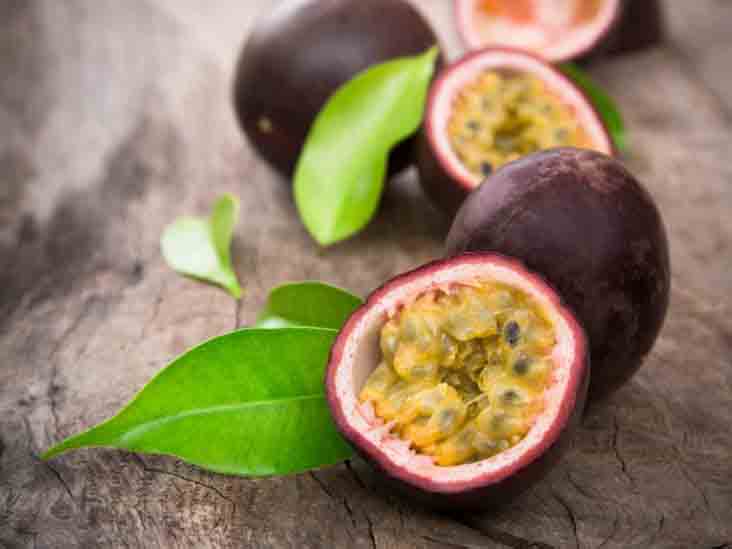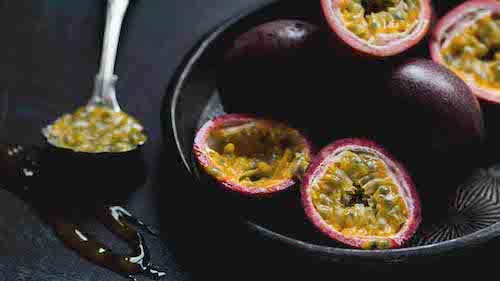Passion Fruit Profile
Written by lisa
Nov 09 2020

Passion fruit is a herbaceous vine in the Passionflower family and the genus Passiflora. It is about 6 meters long. The stem of passion fruit is thin-striped, glabrous; the leaves are papery, 6-13 cm long, 8-13 cm wide, wedge-shaped or heart-shaped at the base, and glabrous; the cyme degenerates only 1 flower, opposite to tendrils; The flower is fragrant, about 4 cm in diameter; the pedicel is 4-4.5 cm long; the bracts are green, broadly ovoid or diamond-shaped, 1-1.2 cm long, with irregular fine serrations on the edge; 5 sepals, green on the outside, green and white on the inside, long 2.5-3 cm; 5 petals, as long as sepals; disc membranous, about 4 mm high; peduncle 1-1.2 cm; 5 stamens; oblong anthers; ovary obovoid; 3 styles, Flat rod-shaped; berry ovoid, 3-4 cm in diameter, glabrous, purple when ripe; seeds are numerous, ovate, 5-6 mm long. The flowering period of passion fruit in June and the fruit period is November. Passion fruit is distributed in the Greater Antilles and the Lesser Antilles, and is widely planted in tropical and subtropical regions. It is cultivated in Guangdong, Hainan, Fujian, Yunnan, and Taiwan in China, and sometimes grows in valleys and jungles at an altitude of 180-1900 meters.
Passion fruit can be eaten raw or used as a vegetable or feed. It has the effect of excitement and strength when used as medicine; the fruit pulp is juicy, added with heavy calcium carbonate and sugar, and can be made into an aromatic and delicious drink. Passion fruit seeds are pressed for oil, which can be used for edible and soap making, paint making, etc.; the flowers are large and beautiful and can be used as garden ornamental plants.
Passion fruit Picture

Passion fruit morphological characteristics
The herbaceous vine of passion fruit, about 6 meters long; the stems have thin stripes, cylindrical or tender stems are sometimes nearly quadrangular, glabrous. The petiole is 1.5-2 cm long and has 2 cup-shaped glands near the top. The leaves of passion fruit are papery, alternate, 6-13 cm long, 8-13 cm wide, wedge-shaped or heart-shaped at the base, palmately 3-lobed, middle lobes ovate, lobes on both sides ovate-oblong, lobes with edges The tips of the incurved glands are finely serrated, and there are 1-2 small cup-shaped glands at the base of the sub loves not curved, glabrous.
The cyme of passion fruit has only 1 flower degenerated, opposite to the tendrils; the flower is fragrant, about 4 cm in diameter; the pedicel is 4-4.5 cm long; the bracts are green, broadly ovoid or diamond-shaped, 1-1.2 cm long, with edges Irregular fine serrations. Passion fruit has 5 sepals, green on the outside, greenish-white on the inside, 2.5-3 cm long, with a horn-shaped appendage at the top of the outside; 5 petals equal in length to the sepals; outer corolla lobes 4-5 rounds, 2 outer rounds The lobes are filiform, approximately the same length as the petals, the base is light green, the middle is purple, and the top is white. The inner 3 lobes are narrow and triangular, about 2 mm long; the inner corolla is not pleated, and the top is completely torn or irregular. , About 1-1.2 mm in height; disc membranous, about 4 mm in height; podophyllum 1-1.2 cm in length; 5 stamens, separated filaments, united at base, 5-6 mm long, flat; anthers oblong, long 5-6 mm, yellowish-green. The ovary of passion fruit is obovoid, about 8 mm long, pubescent; 3 styles, flat rod-shaped, stigma kidney-shaped. Berry ovoid, 3-4 cm in diameter, glabrous, purple when ripe. Passion fruit has a large number of seeds, ovoid, 5-6 mm long.

Passion fruit growth habit and growing environment and distribution
Temperature
The most suitable growth temperature for passion fruit is 20-30℃, and the areas where the annual average temperature is above 18℃ are most suitable for growth. Passion fruit grows slowly when the temperature is above 30℃. The temperature is lower than 15℃ to inhibit vegetative growth. When the temperature is lower than 0℃, the plant will be frozen. Generally, it will grow well at a temperature of not lower than 0℃, and the plant will grow at -2℃. Seriously suffered or even died.
Water
Generally, passion fruit grows best when the annual rainfall is between 1500-2000 mm and is evenly distributed, and it is more drought-tolerant.
Illumination
As a tropical fruit, egg fruit likes full sun to promote the growth of vines and the accumulation of nutrients. Long-day sunshine conditions are conducive to the flowering of passion fruit, and it is most suitable for growth in areas where the annual sunshine hours are 2300-2800 hours.
Soil
Passion fruit has strong adaptability and does not have high requirements on the soil. The pH value of the soil is 5.5-6.5.
Passion fruit Growth habits and distribution
Passion fruit is distributed in the Greater Antilles and the Lesser Antilles and is widely planted in tropical and subtropical regions. It is cultivated in Guangdong, Hainan, Fujian, Yunnan, and Taiwan in China. Passion fruit efficacy and role The medicinal value of passion fruitThe roots, stems and leaves of passion fruit can be used as medicine. It has the functions of excitement, strongness, clearing away heat, refreshing and refreshing, beauty and beauty, nourishing and fitness, preventing and curing stomach, intestinal inflammation, calming pain, improving human immunity and other functions, as well as decompression and reduction. Fat and anti-aging effects. Edible value of passion fruitThe passion fruit contains yellow juice and black seeds. It contains protein, fat, sugar, multiple vitamins and amino acids, among which 15-16% soluble solids and 3.8-4.0% total acid. It is rich in nutrition, sweet and sour, with the aroma of pomegranate, banana, strawberry, lemon, mango, plum and other fruits. The flavor is rich and pleasant. It can be eaten and processed fresh and can be processed into juice, fruit juice, jam, Jelly and lozenge are mainly processed into juice for consumption. The fruit pulp is juicy, added with heavy calcium carbonate and sugar, and can be made into an aromatic and delicious drink. The economic value of passion fruitPassion fruit has a thick and hard peel, which can be used as feed and extract pectin; the seeds are squeezed for oil, which can be used for edible and soap and paint making. The ornamental value of passion fruitThe flowers of passion fruit are large and beautiful and can be used as garden ornamental plants.
Passion fruit cultivation Seed propagation
Seed selection:
Choose the mother tree with strong growth, uniform and large fruit, consistent maturity, and strong stress resistance. The autumn ripe fruit is better. Pick when the fruit is fully mature, and place it indoors for a period to fully ripen and take it out The seeds inside the passion fruit are washed and dried and stored for sowing.
Sowing:
Passion fruit can be broadcast live, but in order to facilitate early management, cultivating strong seedlings and early sowing, seedlings are generally used for transplanting and can be sown after spring until May, and 0.5-0.7 kg per acre when sowing is 0.5-0.7 kg before sowing. Seed soaking can be soaked in clean water for 24-28 hours, or soaked with carbendazim to achieve the purpose of sterilizing passion fruit seeds, breaking dormancy, and improving germination rate. After soaking, sprouting is carried out for 2-3 days. When 80% of the seeds are white, they can be sown. Select plots with good water and fertilizer conditions for the seedbed. As a moisture surface with a width of 1 meter and a length of 4-6 meters, the soil surface must be flat, fine and compacted. The seedbed is best to be soil disinfected, which can be watered with carbendazim or Dixon. After sowing, cover with 0.5-1.0 cm of original fine soil or dung, sawdust and other coverings, and cover with a film for watering.
Seedling Management
After the passion fruit emerges, the flat film is removed, and the arch frame film should be ventilated and cooled to prevent the high temperature from burning the seedlings. Water according to moisture and pull out weeds. When the passion fruit seedlings have 2-3 completely unfolded leaves, thin the seedlings, combined with bagging fake planting, and the fake planted bag seedlings should be watered, because the bag seedlings are easy to dry and die.
The standard for strong seedlings:
seedling height 25 cm, 3 cm from the soil, 0.6-0.8 cm stem diameter, green leaves but not dark green, well-developed root system, and many white roots. Ram propagationThe seedlings germinated from the roots of the passion fruit plant are dug out and planted. Open holes according to the row spacing of 30 cm × 30 cm, and plant 1 plant in each hole.
Latest Updated
- Benefits of Bugleweed - 7 Science-backed Health Benefits
- Bugleweed Dangers & Side Effects - Is It Poisonous?
- How to Plant Evergreen Trees - What You Should Know
- When to Plant Evergreens - Grow Guide for Evergreen Trees
- 12 Wonderful Evergreen Shrubs for Your Garden
- 12 Popular Evergreen Plants with Pictures for Beginners
- When And How To Prune A Lilac Bush Like a Pro
- How to Grow & Care for Lilac Vine (Hardenbergia Violacea)
- Japanese Lilac Tree (Syringa Reticulata) Care & Propagation Guide
- Shumard Oak Pros and Cons - What to Know
Popular Articles
- Winter maintenance of Antirrhinum Majus
- How to Grow Terminalia Mantaly Tree
- How to Grow and Care for Crossostephium Chinense
- How to grow Antirrhinum Majus in spring
- Peristeria Elata (Dove Orchid) Profile: Info & Care Guide
- Underwatered Snake Plant (Sansevieria Trifasciata) - Signs And How To Fix
- How to Care for Brazilian Jasmine Plant (Mandevilla Sanderi)
- How to Grow & Care for Graptopetalum Purple Delight in Summer
- Rosa Chinensis (China Rose): Plant Growing & Care Tips
- How to Care for Baby Sun Rose (Aptenia Cordifolia)